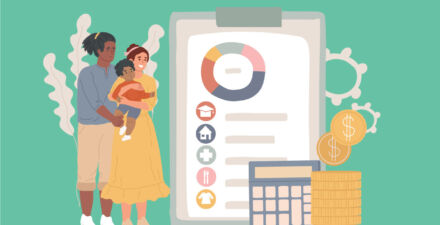Overview
Equitable Growth in Conversation is a recurring series where we talk with economists and other academics to help us better understand whether and how economic inequality affects economic growth and stability. In this installment, Shira Markoff, mobility fellow at the Washington Center for Equitable Growth, speaks with Mishaela Durán, president and CEO of The Forum for Youth Investment, a nonprofit organization advancing equitable youth opportunities and outcomes through quality capacity-building in youth-development systems and youth-centered policy actions. In their conversation, Markoff and Durán discuss:
- The detailed focus of The Forum for Youth Investment
- The lived experience of Durán that informs her work at the Forum
- The relationship between advancing youth opportunities and economic mobility
- How the Forum uses the Opportunity Index to engage states in policy discussions
- The data and academic research underpinning the Opportunity Index
- The policy changes needed to impact economic mobility
- The evidence needed by policymakers to advance youth opportunity and economic mobility
Shira Markoff: Thank you for talking with me today about your work to advance equitable opportunities and economic mobility for youth in the United States.
Mishaela Durán: You’re welcome. I’m delighted to do so.
The detailed focus of The Forum for Youth Investment
Markoff: Can we start with some more detail about the focus of the Forum’s work?
Durán: The Forum’s vision is that all young people reach their fullest potential in education, work, and life. This is our big, broad vision. We do this in three ways. One of our focal points is improving the quality of youth programs across all youth-serving systems. Right now, for example, we’re expanding into youth workforce development.
Secondly, we’re convening state systems leaders to transform public systems. We recently convened state education agencies and state workforce agencies, alongside human services, child welfare, and juvenile justice officials to build a strategy so that we can improve outcomes for young people, particularly in education and work, which is essential for economic mobility. Engaging with young people in some of the deeper-end systems, such as child welfare and juvenile justice, is important because youth often don’t have opportunities for education and work inside or outside the system before they go back into their communities and the workforce.
And lastly, we shape state and federal policymaking. We find that federal policymakers really want to understand where states are innovating and where they’re able to see some impact and improvement. These outcomes are important for federal policymakers because they essentially will follow the lead of the states. So, we think it’s important to push on both of those levers.
The lived experience of Durán that informs her work at the Forum
Markoff: What drew you to the Forum’s work and to working to improve opportunities for youth?
Durán: I come to this work with lived experience. I was involved in the child welfare system in Arizona. I grew up in Apache County, Arizona, which is one of the poorest counties in the nation. My mother was a beneficiary of all the social safety net programs, including Aid to Families with Dependent Children [now Temporary Assistance for Needy Families], food stamps [now the Supplemental Nutrition Assistance Program], Medicaid, the Low Income Home Energy Assistance Program, and Section 8 public housing, in a very rural environment.
Education and work were my way out. There was intergenerational poverty in our family for hundreds of years. My family has been in New Mexico and Arizona for 400 years. I was the first one in my family to go to college and get a 4-year degree. I went into teaching and first taught in the juvenile corrections system.
When I was talking to the young people in the system, I was looking at what their educational experiences had been before they entered it. And there was always one teacher, or a coach, or someone who really supported and mentored them. But when that relationship was disrupted, that’s when things started falling apart for them because they didn’t have a lot of family and community support.
I started looking at the student data when I was teaching in the Arizona Department of Juvenile Corrections, which was warehousing 500 Black, Latino, and Indigenous young men and boys. My youngest student was 12. My oldest was 18, because that was the upper age of juvenile court jurisdiction. I also started looking at the reentry work back into their communities, which was pretty nonexistent. We were just dropping them off at their last address on their 18th birthday.
We knew what was going to happen: They were going to recidivate back into the adult correctional system. So, that led to my focus on policy—particularly educational policy, because that had been my way out. Even for young people in the deep-end systems, if they can just get opportunities to continue their education or to work and receive training, that changes the trajectory of their lives. I know that because I’ve experienced that firsthand in the foster care system, and that’s what drew me to the work at the Forum. It is doing all the things I love— systems transformation, quality improvement, and policy.
The relationship between advancing youth opportunities and economic mobility
Markoff: I know the mission of the Forum is to advance equitable youth opportunities. How do you see that relationship between advancing opportunity and economic mobility?
Durán: Opportunity and economic mobility are inextricably interdependent. I think back to the days when I was struggling. I had dropped out of high school and wasn’t planning on going back, but I realized I was just going to earn the minimum wage, and I was planning on adopting my two kid brothers. So, I had to figure out how to get back into high school.
For a lot of folks, opportunities don’t seem like that much, but they can change the trajectory of a young person’s life. After I reenrolled into high school—a Title 1 school [a school that receives federal funding to support low-income families] but pretty diverse, socioeconomically and racially—there was a local business that had alums from the high school, and I got a job at a local family-owned civil engineering firm. Now, you wouldn’t think that an entry-level, girl Friday position would change my life trajectory, but it did because I was able to support myself.
I was living on my own as soon as I graduated from high school and was able to support myself and go to community college. I wouldn’t have received the opportunity to go to community college without that first job. They were very supportive. They let me work part time, so I could attend college full time, and they gave me health insurance, and that was really important as I didn’t have access to health insurance during that time. These little opportunities might seem small to some but just expanded opportunity for me, such as when an honors program at the local community college prepared me to attend an Ivy League institution, which, of course, opens a lot of doors. All of those little opportunities expanded my horizon tremendously.
How the Forum uses the Opportunity Index to engage states in policy discussions
Markoff: One of the Forum’s major projects is its Opportunity Index. What does the index measure? What do you hope to accomplish with it?
Durán: The Forum’s updated Opportunity Index will be released on September 23, with the latest data from 2020 to 2023. It really paints a picture that opportunity in the United States has stagnated for the past decade across a number of domains, despite some progress in 2022. We measure data across the economy, education, health, and the community domains. We find that youth disconnection continues to rise in what we call the community dimension. We find that 12.1 percent of youth ages 16 to 24 in 2023 are not in school and not working, compared to 10.7 percent in 2021.
We also see declines in the health dimension since 2016, particularly with deaths related to alcohol, drugs, and suicide nearly doubling from 2015 to 2021, especially in communities of color. Health and wellness are essential to economic mobility. If people are not well, they’re not going to be able to hold down a job or be engaged in any sort of educational opportunity. And we’ve seen the youth mental health crisis spike so much, creating a huge disconnection from school. That’s happening earlier and earlier, with chronic absenteeism on the rise at a much younger age than we’ve seen before.
The data that goes into our Opportunity Index is publicly available. We use it to talk to state officials about what their scores are and engage them in a conversation about what is driving this particular score in this domain. We then ask about whether they have implemented policies for universal pre-Kindergarten, for example. We look at other domains, such as volunteerism. How is volunteerism supporting wellness and belonging in communities? We ask because we’re not seeing a high rate of suicides when there is less social isolation among youth.
We use our Opportunity Index to start the conversation with states and also engage young people and parents who have lived experiences within these systems to talk about what it means to them with the states at the table. It supports a dialogue and helps us to understand what the story is behind the data. We will also ask the states what additional data they need to solve social problems and inform policy.
The data and academic research underpinning the Opportunity Index
Markoff: Now I’m curious about how much you use academic research to inform which measures you use in the Opportunity Index or how you’re interpreting what you’re seeing in the data.
Durán: All of the data are synthesized from publicly available data streams, such as Census data. When we engage states in those conversations about data, we also ask if they partner with researchers to focus on a particular policy intervention or if the state commissioned external research and evaluation. The Opportunity Index data are really just to start a conversation with state and local jurisdictions and then see what other evidence we can make available to them if there are gaps. So, again, it’s publicly available large datasets driving the conversations.
Markoff: I’m wondering if you’ve made any changes in the indicators from the previous version to the newest version. Is there anything you’re seeing where maybe we need to look at some new indicators, particularly in the wake of the COVID-19 pandemic?
Durán: We did not change any of the indicators. The last domain that was added was health, back in 2017, with a recalculation of 2016 data, because we knew that was going to be something we needed to track with the dialogue around social determinants of health. When we look at that health domain and the suicides and deaths related to alcohol and drugs, we know that was partly driven by the pandemic. We are going to start engaging the states in conversations about what data elements and metrics are missing and what would be most valuable for policymaking at the state and local level.
The policy changes needed to impact economic mobility
Markoff: So, touching on the policymaking question, based on what you’ve seen from data you’ve collected and research and evidence from the field, what do you think are one or two policy changes at the federal or state levels that would have the biggest impact on economic mobility?
Durán: We think quality matters. If a young person does not feel safe or supported in a program, whether it’s an education or job-training program, then they’re just not going to engage. And we’re not going to see the outcomes or the impacts that we desperately need to see right now with young people.
In 2020, the Forum published results from a 3-year randomized control study of the impact of our intervention, which is called the Youth Program Quality Intervention. What we find is that whether it’s a school-aged child care program or a workforce development program, when programs engage in continuous quality improvement, we see higher-quality programs, better practices, and better outcomes. We see young people engage with a supportive and caring adult, and we see better outcomes across domains.
The Arkansas Department of Education recently commissioned the Forum to study what was going on in their after-school programs at the state level, using our Youth Program Quality Intervention. And we found that students and families had high levels of satisfaction with programs and consistently reported feeling cared for and supported. That’s a big deal, especially with what we’re seeing across the nation with chronic absenteeism, disengagement, isolation, and poor mental health outcomes. And from the youth and parent perspective, they said that their young people were developing college- and career-ready skills, which is super important as they transition into postsecondary education or work. We were really excited about that study and its findings.
Interestingly, too, when we looked at math and literacy scores for the students in those programs that were implementing our Youth Program Quality Intervention, those scores remained stable in that program year, despite statewide scores trending downward. Our policy recommendation is to embed continuous quality improvements into youth-serving programs, such as the WIOA Youth Formula Program or any job-training program. When we talk to appropriators, they tend to say, “Well, these programs are not producing outcomes,” and they don’t want to make an additional investment. So, we have to show that quality supports improved outcomes in employment and earnings.
The other thing we’re recommending is to measure what matters, especially in youth workforce-development programs. The federal government has not built the data infrastructure for states and local workforce agencies or programs to report on employment and earnings data longitudinally. We need to build that infrastructure, and states don’t have the technical expertise to build these siloed data systems on their own.
The states also want to be able to benchmark across states. They really want to know how well they are performing. Yet because the federal government often tells states and locals to just measure outputs, such as how many people were served or what was the average benefit, there’s not a lot of detailed outcome or impact data. We need better data to make shifts in programs to improve them by knowing what’s working and what’s not. I would say that nearly all of the states recommend that the federal government needs to build the data infrastructure because they simply cannot do it on their own.
The evidence needed by policymakers to advance youth opportunity and economic mobility
Markoff: When you’re talking to policymakers to advocate for policy changes, what types of evidence do you find resonate the most with them?
Durán: What I’ve noticed is that outcome and impact metrics resonate most with federal and state policymakers. They’re investing a lot of public dollars. They want to know that what they’re investing in is working. And we have to have more accurate data to inform policy decisions.
For example, Mathematica’s 2018 study that examined job impacts of adult WIOA program participants up to 1 year after they exited the program was an important study that leveraged federal administrative data, coupled with survey data. The federal government doesn’t typically use administrative data such as the HHS-ACF National Directory of New Hires or IRS tax data for research purposes, but we found that when they do, it provides powerful insights. Since this data has integrity and can capture impact metrics, such as earnings and employment, it can be an effective tool to inform policy decisions at the federal and the state levels.
That’s why we’re calling for more data infrastructure, so that we can see what’s working and what’s not. We would love to be able to measure what happens to young people after they exit a youth WIOA program or a Job Corps program. What is their trajectory 1 year, 3 years, and 5 years out after they’re done with the program? And, in terms of earnings, are their earnings going up as we would hope? If not, then what do we need to do differently? Do we need state and local workforce agencies to talk to employers in their state and really make sure there’s a match in how we’re preparing young people for industry and employer needs? I think that could also drive connectivity across sectors.
Markoff: Do you see an openness with the policymakers you talk to about funding to collect data? It’s expensive to collect data and to do evaluations. When you tell policymakers that the data points they’re asking for aren’t available because there isn’t funding to collect it, are they responsive?
Durán: Interestingly, I think when we’ve been talking about the need for data infrastructure with policymakers in the U.S. House of Representatives, there has been resonance. And it comes from an accountability perspective. They want to see better data around outcomes and impact. I have found, though, that often if you can get a provision around research or evidence into an authorizing bill, often the appropriators don’t support it, and it takes a long time to get the appropriation side on board.
I’ve also been in situations where we were advocating for better evidence and when the research study was implemented, it was a narrow literature review and failed to drive policymaking. That doesn’t really help us at all. That is why we think data infrastructure for program and policy improvements matters.
We have some examples of how to build data infrastructure at the state level. The U.S. Department of Education’s investments in Statewide Longitudinal Data Systems have enabled states to do some important work. But these investments are not aligned across the ecosystem. State and federal policymakers are not able to benchmark across 50 states and the District of Columbia. There’s a disconnect between the authorizers and the appropriators. The authorizers want better data, better evidence, and research. But the appropriators often don’t invest in it.
I do think states are doing a better job, such as Kentucky. They used their Statewide Longitudinal Data System, with initial funding from the U.S. Department of Education, to build a really robust data infrastructure that informs policymaking for the governor’s office. The state superintendent of Kentucky’s State Department of Education decided that the data infrastructure they built should not solely house their agency’s data but could be leveraged for the entire Commonwealth. As a result of a forward-thinking, reform-minded agency leader, they added workforce development data into their Statewide Longitudinal Data System and later added their Medicaid data and metrics. Ultimately, they are using it to inform policy, which is so important.
Markoff: What research have you come across recently that has affected your thinking or impacted how you do your work?
Durán: There is a study by psychiatry and behavioral sciences professor Brenden Tervo-Clemmens at the University of Minnesota and her co-authors at the University of Pittsburgh demonstrating that adolescence is a key period for the development—or executive functioning—critical for healthy development. This study maps how executive functioning develops over the course of adolescence, suggesting that ages 10 to 15 are crucial years for executive function development—an understanding that can help inform developmentally appropriate interventions and policies for youth.
We also look at research that our state partners are commissioning because they want to learn how some social policy interventions are working. We have some great partners, such as the WT Grant Foundation, which hosts scholars. Our goal is to link scholars from academia to an ecosystem of state agencies to better understand what is happening in a particular domain. We’ve seen a disconnect between scholars and public systems and agencies. Our goal is to really connect them.
Markoff: For the last question, I want to flip this around and think about how your work can inform the work of academic researchers. What are some key questions that come out of your work that you would like to see researchers dig into?
Durán: That’s a great question. Based on some of the trends evident in our Opportunity Index, we’ve seen the positive impact of pandemic relief. Cash assistance via the expanded Child Tax Credit, for example, reduced child poverty substantially.
So, we’re curious about what level of investment is needed for a combination of guaranteed basic income or cash assistance and the Child Tax Credit to reduce child poverty. What would that look like? Can researchers produce economic data modeling by U.S. Census tracts, so that we can understand what the long-term national gains would be? And then asking: How would those policies affect Gross Domestic Product or regional and local economic activities? And what are the policy incentives at the federal level that we really need to put in place to drive state and local action?
We now have this opportunity to really study these questions. We know these policies worked during the pandemic. Our nation has never seen that kind of drastic reduction in child poverty in our lifetimes. These are the questions that we would love academics to explore.
Markoff: Great. Well, thank you so much for talking with me today. It was a great conversation.
Durán: Yes, thank you so much.
Related
Explore the Equitable Growth network of experts around the country and get answers to today's most pressing questions!






